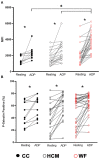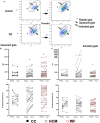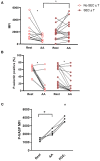Platelet Priming and Activation in Naturally Occurring Thermal Burn Injuries and Wildfire Smoke Exposure Is Associated With Intracardiac Thrombosis and Spontaneous Echocardiographic Contrast in Feline Survivors
- PMID: 35909698
- PMCID: PMC9329816
- DOI: 10.3389/fvets.2022.892377
Platelet Priming and Activation in Naturally Occurring Thermal Burn Injuries and Wildfire Smoke Exposure Is Associated With Intracardiac Thrombosis and Spontaneous Echocardiographic Contrast in Feline Survivors
Abstract
Wildfires pose a major health risk for humans, wildlife, and domestic animals. We previously discovered pathophysiologic parallels between domestic cats with naturally occurring smoke inhalation and thermal burn injuries and human beings with similar injuries; these were characterized by transient myocardial thickening, cardiac troponin I elevation and formation of intracardiac thrombosis. While the underlying mechanisms remain unclear, results from murine models suggest that platelet priming and activation may contribute to a global hypercoagulable state and thrombosis. Herein, we evaluated and compared the degree of platelet activation, platelet response to physiologic agonists and levels of platelet-derived microvesicles (PDMV) in 29 cats with naturally occurring wildfire thermal injuries (WF), 21 clinically healthy cats with subclinical hypertrophic cardiomyopathy (HCM) and 11 healthy cats without HCM (CC). We also quantified and compared circulating PDMVs in WF cats to CC cats. In addition, we examined the association between thrombotic events, severity of burn injuries, myocardial changes, and the degree of platelet activation in cats exposed to wildfires. Flow cytometric detection of platelet surface P-selectin expression showed that WF cats had increased platelet response to adenosine diphosphate (ADP) and thrombin compared to the two control groups indicating the presence of primed platelets in circulation. In addition, cats in the WF group had increased circulating levels of PDMV, characterized by increased phosphatidylserine on the external leaflet. Cats in the WF group with documented intracardiac thrombosis had elevated platelet activation and platelet priming in the presence of ADP. While high dose arachidonic acid (AA) mostly resulted in platelet inhibition, persistent response to AA was noted among cats in the WF group with intracardiac thrombosis. Univariate and multiple logistic regression analyses demonstrated that increased platelet response to AA was independently associated with thrombotic events. This is the first study reporting the significant association between platelet priming and intracardiac thrombosis in domestic cats with naturally occurring wildfire-related injuries and smoke inhalation. Further studies are required to delineate additional mechanisms between inflammation and thrombosis, especially regarding platelet primers and the cyclooxygenase pathway.
One sentence summary: Platelet activation and shedding of platelet-derived microvesicles due to platelet priming is present following naturally occurring wildfire smoke exposure and thermal burn injuries in a population of domestic cats.
Keywords: hypercoagulability; hypertrophic cardiomyopathy (HCM); particulate matter <2.5 μm (PM) 2.5; primary hemostasis; thromboembolism.
Copyright © 2022 Tan, Li, Ueda, Stern, Hussain, Haginoya, Sharpe, Gunther-Harrington, Epstein and Nguyen.
Conflict of interest statement
The authors declare that the research was conducted in the absence of any commercial or financial relationships that could be construed as a potential conflict of interest.
Figures







Similar articles
-
A novel technique to characterize procoagulant platelet formation and evaluate platelet procoagulant tendency in cats by flow cytometry.Front Vet Sci. 2024 Dec 16;11:1480756. doi: 10.3389/fvets.2024.1480756. eCollection 2024. Front Vet Sci. 2024. PMID: 39742312 Free PMC article.
-
Cats with thermal burn injuries from California wildfires show echocardiographic evidence of myocardial thickening and intracardiac thrombi.Sci Rep. 2020 Feb 14;10(1):2648. doi: 10.1038/s41598-020-59497-z. Sci Rep. 2020. PMID: 32060317 Free PMC article.
-
Platelet activation in cats with hypertrophic cardiomyopathy.J Vet Intern Med. 2014 Mar-Apr;28(2):411-8. doi: 10.1111/jvim.12325. Epub 2014 Feb 24. J Vet Intern Med. 2014. PMID: 24612013 Free PMC article.
-
Spontaneous HIT syndrome: Knee replacement, infection, and parallels with vaccine-induced immune thrombotic thrombocytopenia.Thromb Res. 2021 Aug;204:40-51. doi: 10.1016/j.thromres.2021.05.018. Epub 2021 Jun 9. Thromb Res. 2021. PMID: 34144250 Review.
-
Mechanisms of platelet activation: need for new strategies to protect against platelet-mediated atherothrombosis.Thromb Haemost. 2009 Aug;102(2):248-57. doi: 10.1160/TH09-03-0192. Thromb Haemost. 2009. PMID: 19652875 Review.
Cited by
-
Wildfire Smoke Exposure during Pregnancy: A Review of Potential Mechanisms of Placental Toxicity, Impact on Obstetric Outcomes, and Strategies to Reduce Exposure.Int J Environ Res Public Health. 2022 Oct 22;19(21):13727. doi: 10.3390/ijerph192113727. Int J Environ Res Public Health. 2022. PMID: 36360613 Free PMC article. Review.
-
Sodium Butyrate Attenuates AGEs-Induced Oxidative Stress and Inflammation by Inhibiting Autophagy and Affecting Cellular Metabolism in THP-1 Cells.Molecules. 2022 Dec 9;27(24):8715. doi: 10.3390/molecules27248715. Molecules. 2022. PMID: 36557849 Free PMC article.
-
A novel technique to characterize procoagulant platelet formation and evaluate platelet procoagulant tendency in cats by flow cytometry.Front Vet Sci. 2024 Dec 16;11:1480756. doi: 10.3389/fvets.2024.1480756. eCollection 2024. Front Vet Sci. 2024. PMID: 39742312 Free PMC article.
-
Prothrombotic Biomarkers Are Not Altered by Wood Smoke: A Pilot Controlled Exposure Study.FASEB Bioadv. 2025 Jul 8;7(7):e70038. doi: 10.1096/fba.2025-00125. eCollection 2025 Jul. FASEB Bioadv. 2025. PMID: 40641849 Free PMC article.
-
Evolving FATE: A New Lens on the Pathogenesis and Management of Feline Cardiogenic Arterial Thromboembolism.Animals (Basel). 2025 Jun 1;15(11):1630. doi: 10.3390/ani15111630. Animals (Basel). 2025. PMID: 40509097 Free PMC article. Review.
References
LinkOut - more resources
Full Text Sources
Research Materials
Miscellaneous

